Finishing a marathon is an achievement on its own, but breaking the 3-hour barrier is a significant milestone that many runners spend years working towards. It requires a blend of extensive physical preparation, mental toughness, and strategic planning. This guide will outline the essential steps to help you achieve a sub-3 hour marathon, focusing on training, healthy lifestyle choices, pacing, motivation, and race-day strategies.
1. Establish a Training Plan
Setting up a well-structured training plan is crucial for achieving your marathon goal. Here’s how to get started:
- Assess Your Current Fitness Level: Before you start, evaluate your current fitness level. This will help you set realistic goals and create a plan that suits your needs. The 3-hour marathon is no small feat, so it's key to know where you're at and how much you need to improve to achieve it.
- Set a Timeline: A typical training plan lasts 12-20 weeks, but breaking 3 hours will take much more than a few months. Building endurance to this level takes years of consistent training. After assessing your current fitness level, you may need to add goals to use as checkpoints. For example, if you have a PR of 3:30, you may set a timeline for breaking 3:15 as a checkpoint. This way, you can evaluate your progress and make adjustments along the way.
- Choose a Training Program: COROS offers several training programs to help marathoners reach their goals. Plans of varying lengths & abilities are available in our training library. If you're already close to the 3:00 barrier, you might consider the 2:45-3:00 Plan. Runners that may have a little further to go could start with the Sub-3:15 Plan instead. Progressing through multiple plans is common for marathoners with long-term goals.
- Monitor and Adjust: Use the data from your COROS watch to monitor your performance and make necessary adjustments. Track your base fitness, training load, and recovery to ensure you’re on track.
Coaches Tip: Some runners may need a specific training plan to meet their individual training needs. COROS Coaches have helped countless runners in this same situation. Send an email to coach@coros.com for free advice on how to select a plan and make it meet your specific needs!
Common Marathon Training Workouts
Below are a few workouts you will likely encounter during your marathon training:
- Base Run - These are standard, easy runs at Aerobic Endurance (Zone 2) intensity. Some base runs also include strides. Base runs are targeted to enhance your endurance and efficiency without overexerting yourself.
- Tempo Run - Tempo workouts are long, extended efforts in the Aerobic Power Zone (Zone 3). These can range up to 7 miles in some plans, and are at a similar effort to marathon pace for runners at this level.
- Long Run - Long runs are the longest run of the week, and often double-dip as a hard session. Many long runs feature extended bouts at marathon pace. These can be the most specific workout for the marathon, since you'll be expected to hit marathon pace after 10+ miles, just like during a race.
- Interval - Intervals are repeated bouts of higher-intensity running with a rest in between. For marathon training, the rest typically consists of running in zone 1 or 2 rather than standing. The intensity of the intervals may range from Marathon Pace to Threshold Pace (Zone 4).
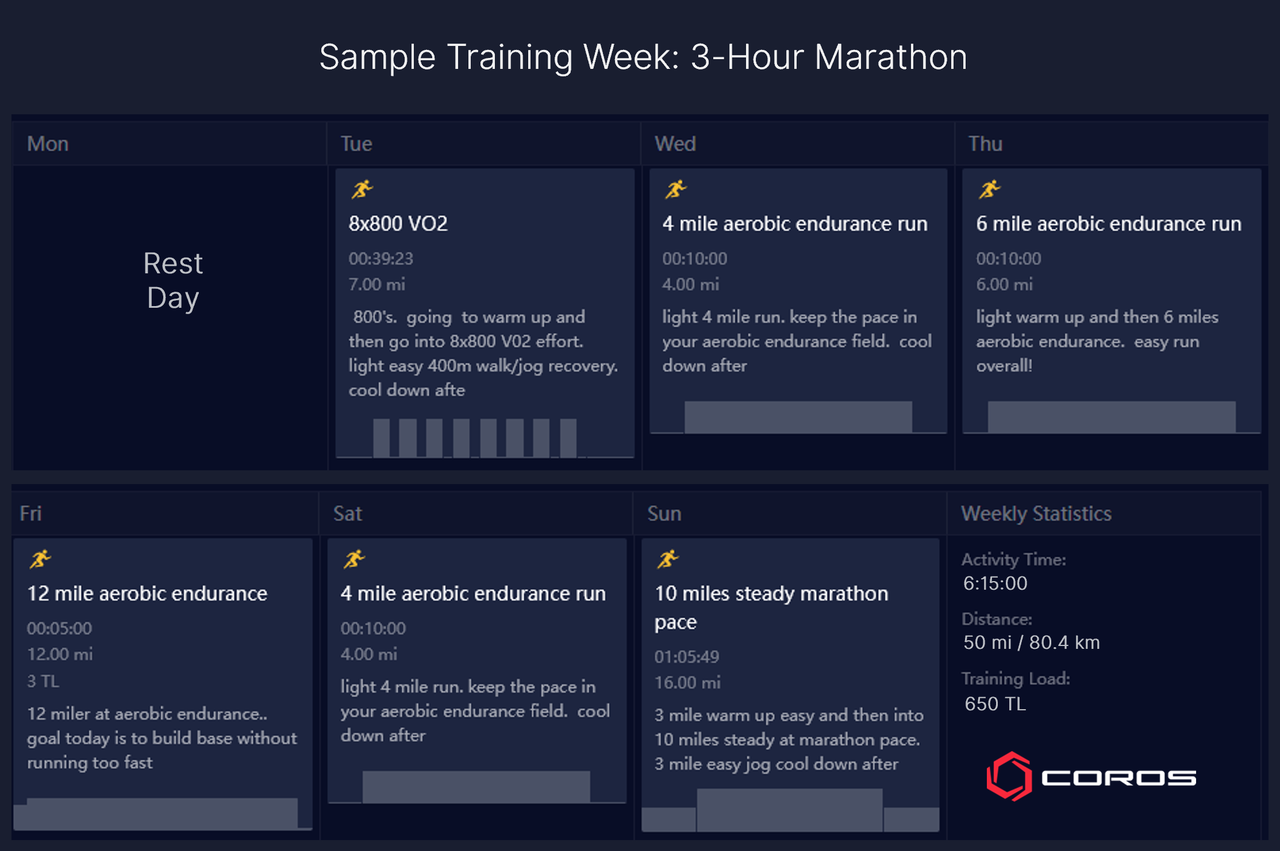
An example of a training week for a 3-hour marathoner. This week includes an interval workout (Monday), base runs (Tuesday-Saturday), and a long run (Sunday)
2. Know Your Marathon Pace
Pacing is critical to achieving any marathon goal. To finish in under 3 hours, your average pace should be 6:51 per mile (4:15 per km) or faster. This average pace is called Marathon Pace, and is a critical number to know.
For a runner targeting a time just under 3 hours, their marathon pace should fall in Zone 3. Experienced marathoners may notice this is different compared to goals of 4 hours or more. This is because the intensity you can hold for 3 hours is different from the intensity you can hold for 4 hours. The faster one can run a marathon, the closer their marathon pace will get to Threshold Pace (in Zone 4). For more information on pacing, be sure to check out the COROS Coaches pacing strategy guide!
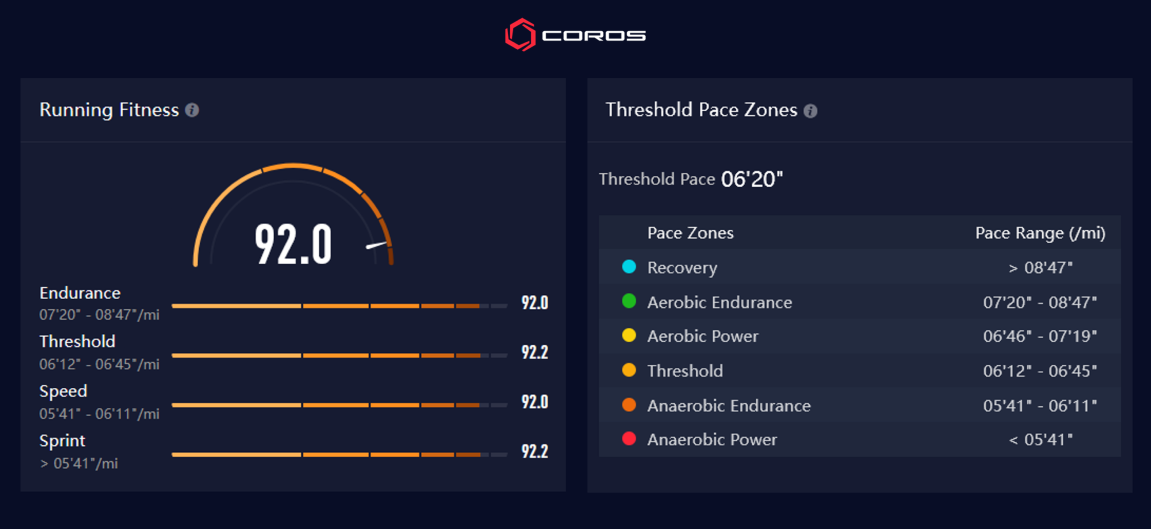
Running Fitness & Threshold Pace Zones for a 2:59 marathoner. Their Marathon Pace (6:51/mi) is in their Aerobic Power zone.
It's important to practice your marathon pace often during training, so the COROS training plans incorporate this pace into several workouts throughout the plan. Workouts like the long runs mentioned above give your body the necessary tools to run marathon pace for 26.2 miles, along with a great confidence boost from knowing you can handle the pace!
Many races also have professional pacers for major time goals (like 3 hours), so be sure to research your race and see if this is an option for you.
3. Track Your Progress
Staying motivated and setting clear goals are essential to keeping you on track during your training. While the outcome goal is fairly clear (run under 3 hours), you should also have smaller goals along the way to track your progress.
COROS provides many ways to track your progress, and training plans have built-in goals every step of the way. For example, the calendar page shows your projected Base Fitness & Training Loads to track your fitness progress, and COROS provides effort accuracy to see if you are meeting your goals within each workout!
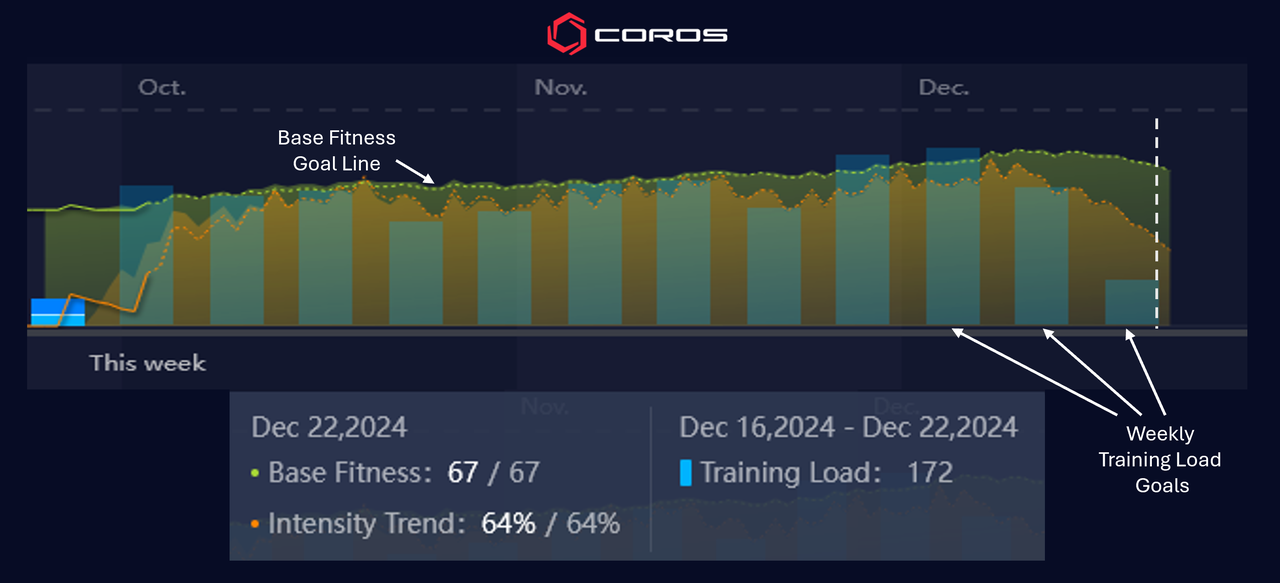
A training plan on the "Calendar" page of Training Hub, showing future Base Fitness, Intensity Trend, and Weekly Training Load values.
Periodically throughout your training, it is important to check in on your training metrics to see how you are progressing. COROS EvoLab provides several metrics that can indicate progress towards a sub-4 hour marathon.
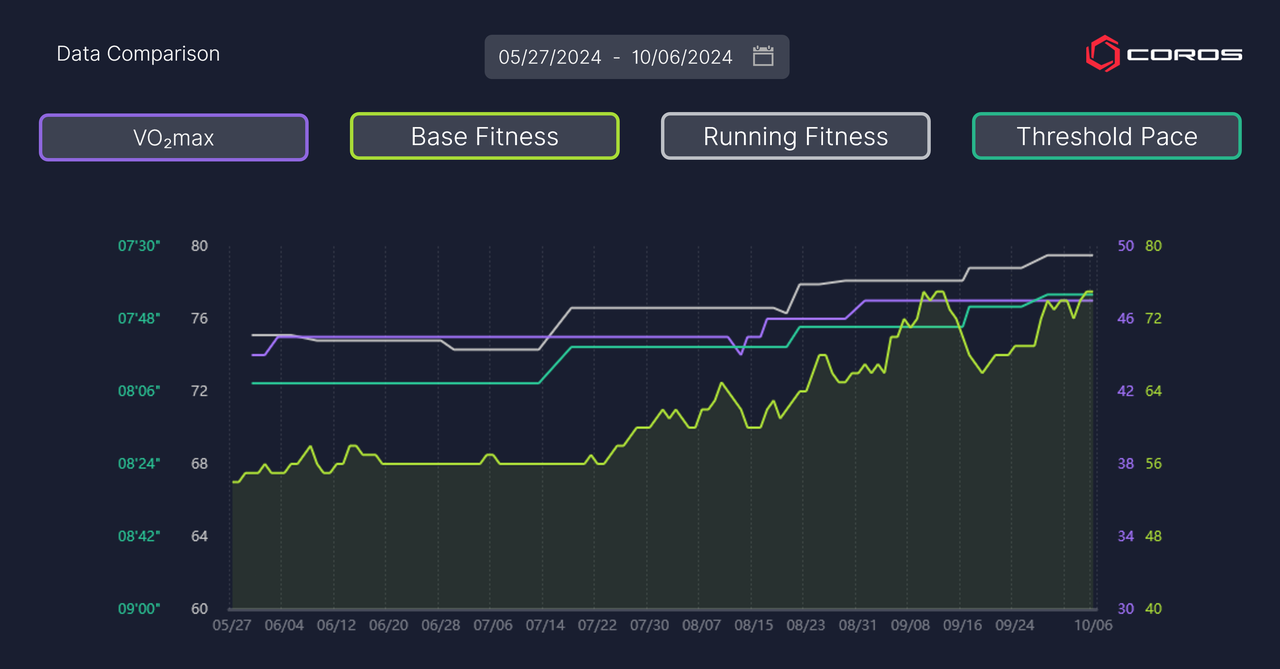
Changes in VO₂max, Base Fitness, Running Fitness, and Threshold Pace over a quality 20-week training period.
- VO₂max: This is the measure of your aerobic ability. The 'O₂' stands for Oxygen, the source of sustainable aerobic energy. A higher VO₂max means you can deliver more oxygen to your muscles, and have a larger supply of sustainable energy. VO₂max is affected by nearly every workout, but base runs and long runs are specifically targeted towards this metric.
- Base Fitness: This is a measure of how much training load your body can handle. A base fitness of 70 means your body can handle workouts with 70 training load and recover with ease. Some workouts will produce training loads well above your base fitness (150, for example). These sessions will require extra recovery time.
- Running Fitness: While it sounds like Base Fitness, Running Fitness relates to pace instead of training load. As you progress and can run faster at the same effort, your pace zones (shown in section 2) will adjust, and your Running Fitness score will increase. Tracking this metric is critical to know your progress. Someone with a 3-hour marathon typically has a Running Fitness score of 96 for women / 92 for men. Everyone is different, though, so while this is a good target to shoot for, it does not translate directly to marathon performance.
- Threshold Pace: Like Running Fitness, Threshold Pace will adjust as you get into better shape. This pace is the point where you begin to rapidly fatigue, so it is a line that marathoners typically do not cross. However, an increase in threshold pace typically coincides with an increase in Marathon pace, so it is still a good indicator of progress.
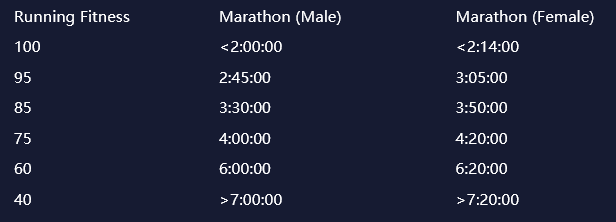
Running fitness scores roughly translated to marathon times
To stay motivated, try to share your training journey with supportive family & friends. Talking frequently with them about your goals & overall progress will keep you accountable for the duration of your training. Additionally, a training partner can provide accountability within workouts, so don't be afraid to invite a buddy to run with you!
4. It's More Than Just Running
Training is all about giving your body the tools it needs to get better. The various forms of running are a big part of that, but it doesn't stop when the workout ends. When you break down your body during workouts, you then need to build back stronger. The decisions you make when you're not running have a strong effect on how well your body rebuilds.
- Sleep: Prioritize getting 8-9 hours of sleep per night. Sleep is crucial for getting the most out of your training. The REM stage is where your body adapts and rebuilds the most. This stage is most active in the 7th, 8th, and 9th hours of sleep, so don't miss out on this critical part of training! When you wear your watch to sleep, COROS will track your sleep quality and duration.
- Stress Management: Incorporate stress-relief practices such as meditation, yoga, or hobbies that help you relax. High stress levels can negatively impact your training and recovery, even if you do everything else right.
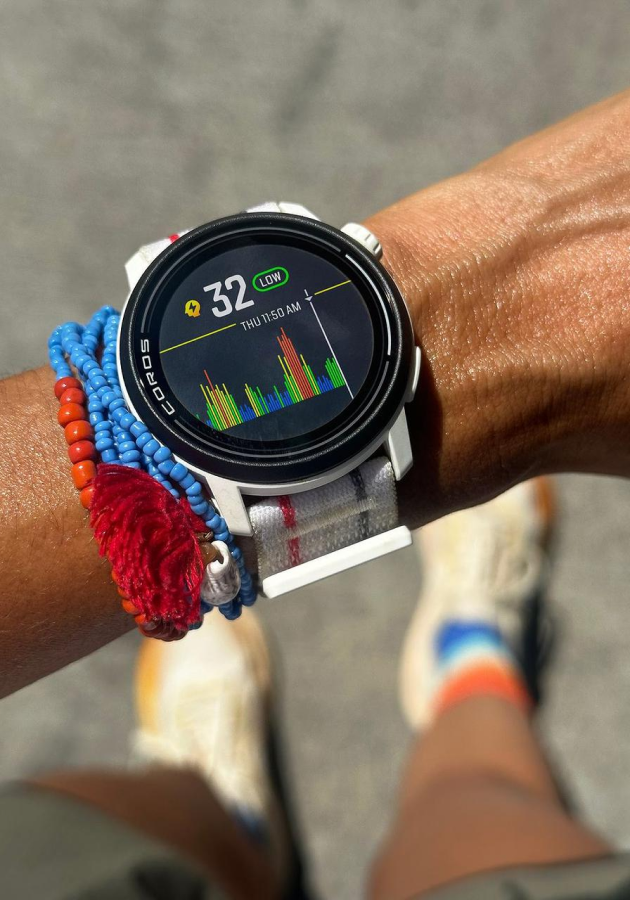
COROS includes all-day stress tracking, making stress management easier to analyze
5. Mental Preparation
Running a marathon is as much a mental challenge as it is a physical one. Prepare your mind for the demands of race day:
- Visualization: Visualize yourself running the marathon successfully. Imagine the start, the challenging middle miles, and crossing the finish line under 3 hours. It is also helpful to review the course beforehand to know what race day will look like.
- Self-Talk: Develop positive mantras to repeat during tough moments in the race. Phrases like "I am strong" or "I can do this" can provide a mental boost. Be sure to practice this in workouts, too. It can give you a boost during training and will make it easier to stay positive on race day.
- Break the Race into Chunks: Mentally divide the marathon into smaller segments (e.g., 5 miles at a time). Focus on completing each segment rather than the entire race. If one segment doesn't go well, this makes it easier to move on to the next and provide a mental reset.
- Confidence: The power of belief is a wildly underrated tool. A runner who believes they can reach their goal is much more likely to achieve it. Everything you have done along the way is within your COROS App, making it easy to reflect on how far you've come. It serves as a great reminder that hard work pays off, and how well-prepared you really are.
6. Race Day Execution
On race day, follow these tips to ensure you stay on track for a sub-3 hour finish:
- Set Up Your Virtual Pacer: Use your GPS watch to monitor your pace. The virtual pacer feature can help you know how far ahead or behind pace you are, without any unnecessary alerts.
- Warm-Up: It is always best to get your blood flowing and muscles ready before you perform. COROS recommends a dynamic warm up routine and a short jog.
- Start Under Control: Resist the urge to start too fast. Stick to your planned pace and avoid getting carried away by the excitement of the start. You won't run your marathon pace for the entire 26.2 miles. Some parts will be faster, others will be slower. Running ahead of pace early can be disastrous when you reach the mental challenges later in the race. If your pace is fading when those challenges hit, they become even harder to overcome. If you're on a roll and increasing your pace at that point, the mental challenges feel much easier.
- Stay Positive: Keep a positive mindset, especially in the later miles. Remember your training and the hard work you’ve put in.
By following these 6 keys and staying committed to your training, you’ll be well on your way to achieving a sub-3 hour marathon. Remember, consistency and patience are key. Trust the process, believe in yourself, and enjoy the journey to this incredible milestone!
/fit-in/0x18/coros-v2/images/common/logo_black.png)